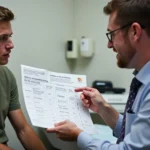Cancer remains one of the leading causes of death worldwide, but thanks to advances in medical science, early detection has become one of the most powerful tools in the fight against this pervasive disease. Early cancer detection can significantly improve the chances of successful treatment, reduce the severity of interventions, and ultimately save lives. The key to increasing survival rates lies in catching cancer when it is most treatable—before it spreads to other parts of the body.
While there is no one-size-fits-all approach to cancer detection, experts agree that a combination of regular screenings, awareness of risk factors, and a proactive attitude toward health can lead to early identification of various cancers. In this step-by-step guide, we explore the recommended methods for early cancer detection, backed by the latest research and expert insights.
Step 1: Understand Your Risk Factors
Before diving into specific screening tests, it is crucial to understand that cancer risk factors vary from person to person. These factors can be genetic, environmental, or lifestyle-related, and they often determine the type of cancer screenings that should be prioritized. Some key risk factors include:
-
Family History: A history of cancer in your immediate family increases your risk for certain types of cancer, such as breast, colorectal, and ovarian cancer. Genetic mutations, such as BRCA1 and BRCA2 (linked to breast and ovarian cancers), also play a significant role.
-
Age: The risk of developing many cancers, including breast, prostate, and colorectal cancer, increases with age. For instance, colorectal cancer screenings are typically recommended to start at age 45 for people at average risk, and earlier for those with a family history.
-
Lifestyle Factors: Smoking, excessive alcohol consumption, poor diet, and a lack of physical activity all contribute to a higher risk of cancer. Weight management and regular exercise are vital steps in reducing the risk of several cancers, including lung, liver, and colorectal cancers.
-
Environmental Exposures: Prolonged exposure to certain chemicals, radiation, or even ultraviolet (UV) light can increase the risk of developing cancer. Occupational exposure to harmful substances (e.g., asbestos or pesticides) also requires specific vigilance.
Once you have a clear understanding of your individual risk factors, you can collaborate with your healthcare provider to tailor a screening schedule and preventative strategy that’s best suited to your needs.
Step 2: Regular Screening Tests
The cornerstone of early cancer detection is routine screenings. Early detection through screening can identify cancer in its most treatable stages, sometimes before symptoms even appear. Several cancer screenings are recommended by experts, depending on risk factors and age. Some of the most common and proven screening tests include:
Breast Cancer: Mammograms
Mammograms are X-ray images of the breast tissue and are one of the most effective tools in detecting early-stage breast cancer. According to the American Cancer Society (ACS), women at average risk should begin annual mammograms at age 45, although women aged 40-44 can opt to start screening earlier.
In addition to mammograms, breast self-exams and clinical breast exams by a healthcare provider are recommended for women, though they are not substitutes for regular mammograms.
Colorectal Cancer: Colonoscopy and Stool Tests
Colorectal cancer is one of the leading causes of cancer-related deaths, but it is also highly preventable and treatable when detected early. For most individuals, screening should begin at age 45, with a colonoscopy recommended every 10 years. During a colonoscopy, a doctor can detect abnormalities in the colon and rectum, such as polyps, which may turn cancerous over time.
For those who are at average risk but are unable or unwilling to undergo colonoscopy, alternative tests, such as the fecal immunochemical test (FIT) or stool DNA tests, can detect blood or abnormal cells in the stool. These tests are less invasive and may be a viable option for some patients.
Cervical Cancer: Pap Smear and HPV Testing
Cervical cancer, which is caused by the human papillomavirus (HPV), is one of the few cancers that can be prevented through vaccination and regular screening. Women should start having Pap smears at age 21, with screenings every three years. After age 30, co-testing with both a Pap smear and an HPV test is recommended every five years.
The HPV vaccine is also an essential tool in preventing cervical cancer, particularly for those who receive the vaccine before becoming sexually active. The vaccine is recommended for both boys and girls, typically between the ages of 11 and 12.
Prostate Cancer: PSA Testing
Prostate cancer is common among older men, but the decision to undergo screening with the prostate-specific antigen (PSA) test is more nuanced. Experts suggest that men at average risk should begin discussing the pros and cons of PSA testing with their healthcare provider at age 50, while men at higher risk—such as those with a family history of prostate cancer—may consider screening as early as age 40 or 45.
The PSA test measures the level of prostate-specific antigen in the blood, with elevated levels potentially indicating the presence of prostate cancer. However, it’s important to note that PSA tests can lead to false positives, and further testing, such as a biopsy, may be required for confirmation.
Skin Cancer: Dermatological Exams
Skin cancer, particularly melanoma, has become increasingly common due to rising rates of UV exposure. Regular dermatological exams are key in identifying early signs of skin cancer, especially for individuals with a history of sunburns, fair skin, or a family history of skin cancer.
In addition to professional exams, individuals should conduct regular self-exams to look for new moles or changes to existing ones. The ABCDE rule (Asymmetry, Border irregularity, Color variation, Diameter greater than 6mm, and Evolving nature) is an easy guideline to remember when assessing moles.
Step 3: Genetic Testing and Risk Assessment
For those with a family history of cancer or certain genetic predispositions, genetic testing can provide valuable insights into an individual’s risk. Tests like the BRCA1 and BRCA2 gene tests for breast and ovarian cancer risk or the Lynch syndrome test for colorectal cancer can help detect genetic mutations that increase the likelihood of cancer.
Genetic counseling is recommended before and after testing to fully understand the implications of the results. It’s important to note that genetic testing is not recommended for everyone, and its utility often depends on family history and other personal risk factors.
Step 4: Know the Warning Signs and Symptoms
While routine screening is essential, being aware of the early warning signs of cancer is just as important. Cancer often presents with subtle symptoms that can be easily overlooked. Some common early warning signs include:
-
Unexplained weight loss
-
Persistent fatigue or weakness
-
Changes in bowel or bladder habits
-
A lump or thickening in the breast or elsewhere
-
Difficulty swallowing or persistent indigestion
-
Unexplained bleeding or bruising
-
Skin changes or sores that don’t heal
If you experience any of these symptoms or notice significant changes in your body, it is important to seek medical advice immediately. Early detection can make a significant difference in prognosis.
Step 5: Regular Follow-Up and Preventive Care
Once you’ve undergone screening, it’s important to maintain regular follow-up appointments with your healthcare provider. Consistent monitoring ensures that any potential issues are addressed promptly. Preventive care—such as vaccinations (e.g., the HPV vaccine or the Hepatitis B vaccine) and lifestyle modifications (healthy diet, exercise, smoking cessation)—plays a key role in cancer prevention.
Conclusion
Early cancer detection is a critical part of modern healthcare, offering hope for more effective treatments, reduced mortality, and improved quality of life. By understanding personal risk factors, adhering to recommended screening guidelines, and being vigilant about any changes in your body, you can significantly increase your chances of detecting cancer at an early, more treatable stage. Remember, cancer may be a daunting diagnosis, but with early intervention, the fight against it is far from over. By taking these proactive steps and consulting with healthcare professionals, you are investing in your health and your future well-being.















